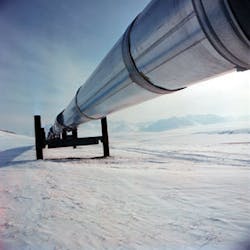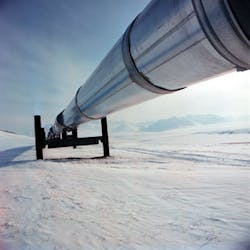The difficulties entailed in pipeline installation, operation, and maintenance are magnified dramatically in the challenging physical and geographical conditions that deepwater and arctic operations present.
Compounding the challenge of technological solutions to accommodate such conditions is the charge that pipeline operators and contractors carry in these areas, in that they are also environmentally sensitive.
Deepwater challenges
Ultradeepwater pipelaying is clearly a challenge, with water depths of 3,000 m being targeted for some development, noted Allen Leatt, chief technology office for Acergy SA (formerly Stolt Offshore), Sunbury-on-Thames, England.
“At this depth, very large lay tensions are required, resulting in high-specification installation vessels and equipment,” he said. “To meet these challenges Acergy invested in a new 750-ton tension J-lay tower for the Acergy Polaris [derrick lay barge]. The tower is now installed and operational on the BP Greater Plutonio project [off Angola].”
Leatt contends that the environmental impact of pipeline trenching and burial may present future challenges for the industry: “Minimizing seabed disturbance and turbidity presents challenges to today’s burial techniques.”
Other hurdles loom in deepwater pipeline installation as distances from seabed to production facilities lengthen with more ambitious projects.
“For the deepwater market today, pipelines remain relatively short,” Leatt said. “However, this is changing with the innovation of Low Dosage Hydrate Inhibitors now enabling longer tiebacks. As these lines become more sophisticated (clad lines, heavily insulated lines, or HDPE water injection lines), onshore fabrication will become more cost-effective.”
Leatt also sees innovations in pipeline insulation characteristics-either active, via electrical heating, or passive, via improved coatings-making a crucial difference to offshore pipelay operations.
“Their ability to minimize the requirement for pipe-in-pipe solutions and heavily insulated lines, with their corresponding high installation tensions, will result in improved project pipelaying economics,” he said.
For large offshore trunklines, the ability to monitor and record the amount of fatigue every single joint experiences during installation ensures that the as-built documentation represents the material state of the pipeline following installation, Leatt said.
“Acergy conducted such measurement during the installation of the Langeled Pipeline [in the Norwegian North Sea] from the Acergy Piper [lay barge]. For the total installation of 900 km, the individual fatigue of every single joint was delivered to the operator as part of the design, fabrication, and installation dossier.”
New standards needed
Standardizing information about the world’s offshore pipelines would go a long way toward aiding pipeline operators and contractors working on the growing global deepwater infrastructure, according to John Stearns, vice-president, marine pipeline systems, INTEC Engineering, Houston. INTEC is a division of the Heerema Group.
Broader use of geographic information systems (GIS) databases to store and retrieve information throughout a project’s life cycle would be especially beneficial to deepwater development.
“GIS previously has been the domain of onshore pipelines,” Stearns noted. INTEC’s vision is to make GIS database an industry standard. The database would contain all design information, material quality assessment/quality control [QA/QC] information, fabrication QA/QC information, and installation QA/QC information, as well as inspection, maintenance, and repair information.”
Stearns would also like to see an industry standard for offshore pipeline risk assessment, where failure frequencies are data-based.
This “would increase opportunities for evaluation among multiple disciplines and improve decision-making for pipeline integrity. An industrywide knowledge base also would allow designers to focus on mission-critical elements for effective integrity management.”
Technology innovations
More research and development is needed in certain technology areas to improve assurance of pipeline integrity in challenging environments, according to Stearns.
“In the near term, industry R&D should focus on expanding the ability of MFL [magnetic flux leakage] inspection tools to inspect thick-wall pipes,” he said. “Industry also requires new techniques, adapted and commercially viable, to assess the integrity of multidiameter pipelines and to detect fatigue cracks at high-fatigue locations in pipelines and risers, including both parent metal and weld areas.
Other areas where R&D could improve pipeline system integrity, said Stearns, without adding significant costs or that could improve project economics while maintaining or enhancing pipeline integrity, are:
- Development of higher-integrity, watertight, field joint coating systems for use in fatigue-loading situations. “Industry could then use less-stringent in-air crack growth rates for the fatigue design, compared with accepting the penalty of crack-growth rates in seawater with cathodic protection.”
- Improvements in automated ultrasonic inspection for internally clad steel risers.
- Improved understanding of fatigue performance of corrosion resistant steel for catenary risers.
- Welding of ultrahigh-strength pipelines.
- Improved understanding of fatigue damage to offshore girth welds from low stresses in the loading spectrum.
Arctic realms
Leatt also pointed to arctic frontier areas such as the Barents Sea that present significant environmental challenges for contractors.
“As an EPIC [engineering, procurement, installation, and construction] contractor, Acergy recognizes that we occupy a critical position, even if limited in time, in the lifecycle of a pipeline,” he said. “The remoteness of operation and environment presents many challenges for equipment, vessels, and logistics. Lessons learned from remote operations in West Africa, the harsh and challenging environment of the North Sea, together with investing in the right equipment and vessels, will enable the successful development of these regions.”
Apart from new deepwater and arctic challenges, Leatt also expressed concern over the state of the world’s existing offshore pipeline infrastructure.
“As offshore basins mature, the corresponding infrastructure is aging,” he noted. “As with any maturing asset, the operational expenditure required to effectively maintain the system increases, while the production curve of the asset decreases.
“Through effective integrity management systems, the pipeline owner effectively manages the environmental risks. Key to this will be the inspection, maintenance, and repair programs put in place to ensure proactive management of the pipeline.”
The final environmental challenge for the pipeline owners will be the decommissioning of pipelines, he added.



